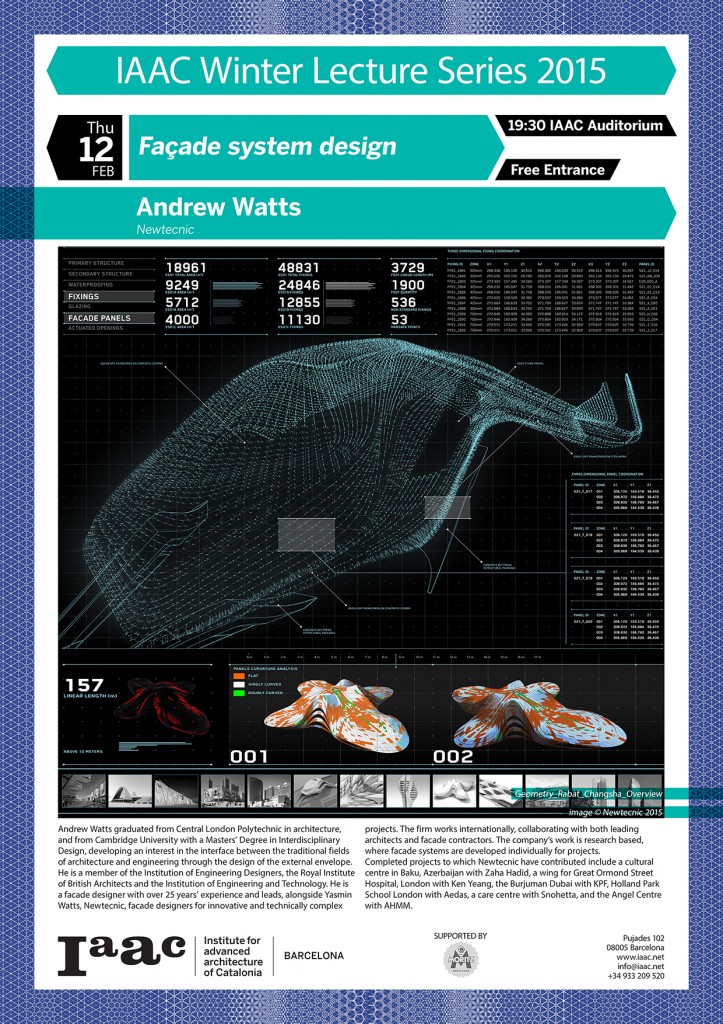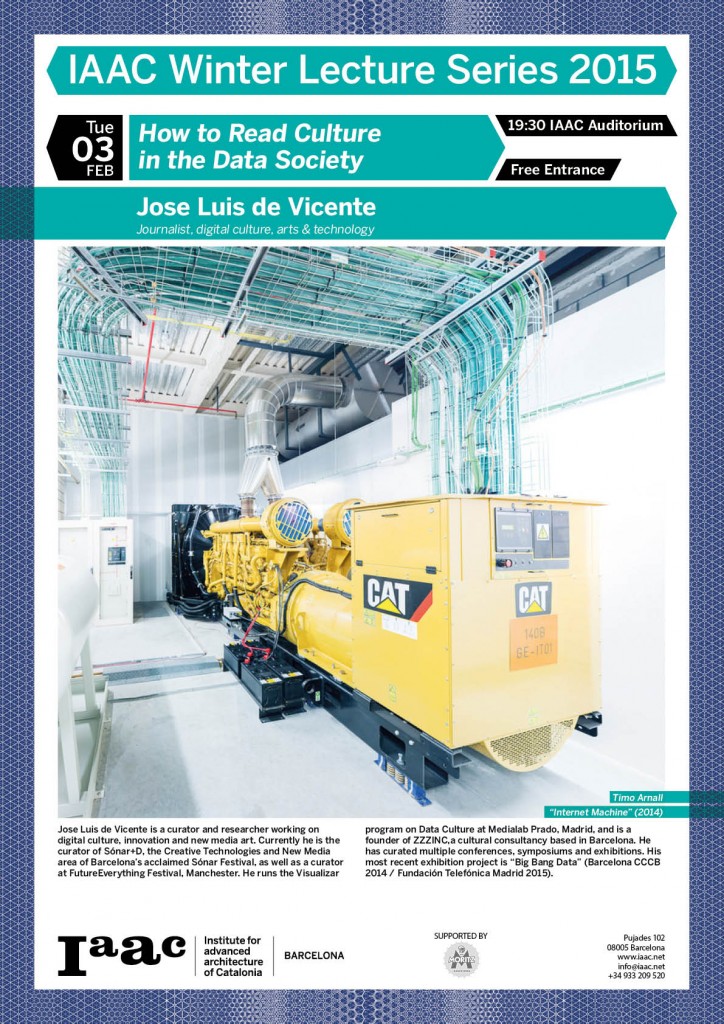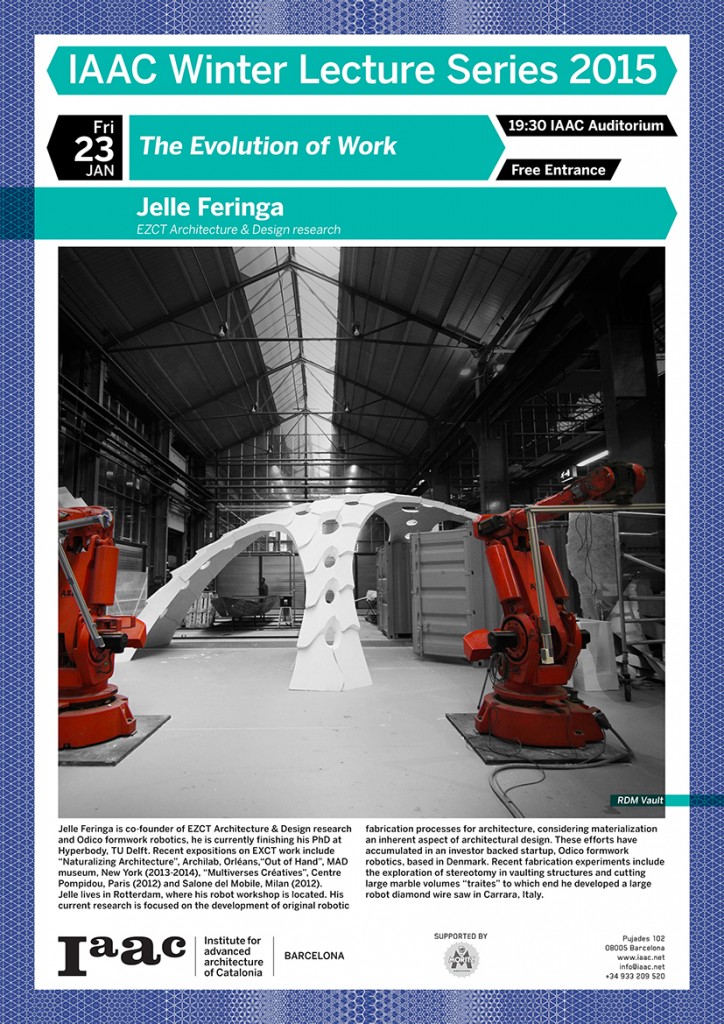IaaC Blog
Inside the Institute
MAA 2014-2015
MAA 02
MAI
Valldaura Labs
Open Thesis Fabrication
Research Trips
Category Archives: Uncategorized
Thursday 12th of February // Andrew Watts // Façade System Design
Also posted in IAAC event Leave a comment
Jose Luis de Vicente // How to Read Culture in the Data Society
Tonight we had the pleasure of hosting Jose Luis de Vicente as part of the IAAC Winter Lecture Series 2015. Jose Luis is a curator and researcher working on digital culture, innovation and new media art. Currently he is the curator of Sónar+D, the Creative Technologies and New Media area of Barcelona’s acclaimed Sónar Festival, as well as a curator at FutureEverything Festival, Manchester. He runs the Visualizar program on Data Culture at Medialab Prado, Madrid, and is a founder of ZZZINC,a cultural consultancy based in Barcelona. He has curated multiple conferences, symposiums and exhibitions.
During his conference Jose Luis took us through his thoughts regarding the possibility of reading culture in the data society, showing us some of his works, and in particular his latest exhibition project, “Big Bang Data” (Barcelona CCCB 2014 / Fundación Telefónica Madrid 2015). For Jose Luis data is one of the essential building blocks of society today. it is produced by our everyday activity and by the operation of all systems in the modern world: from transport to shipping to the vast machine of the technologies of capitalism. Data is also produced in the social space and a form of representation of how we live and think today. This presentation is a journey through stories and narratives of data, and the way we tell stories about how it is shaping the world.
Also posted in IAAC event Leave a comment
Tuesday 3rd of February // Jose Luis de Vicente // How to Read Culture in the Data Society
Also posted in IAAC event Leave a comment
Dave Pigram // Experiments in Design and Fabrication
Today we had the pleasure of hosting Dave Pigram as part of the IAAC Winter Lecture Series 2015, giving a nice Aussie closing to our Australia Day Barbecue!
Dave started with his experience in more general terms on experimenting in design and fabrication, then moving on to more specific examples of this practice. In particular Gaudi’s Puffy Jacket, an experiment that had an initial phase in IAAC 2 years ago, as part of the Master in Advanced Architecture 2012/13 Negotiated Formations Workshop, run by Dave and his professional Partner Iain Maxwell (Supermanoeuvre). Gaudi’s Puffy jacket is a thin-shell precast pavilion, a playful tribute to the seminal research on form-finding conducted by Antonio Gaudi. This experiment was then further developed by Dave and his students at UTS in Sydney, proposing a more complex design, an applying the material learnings of the workshop developed in IAAC.
Dave then moved on to explain the HiLo project, currently being developed by a Core Design and Research Team consists of four partners, with the two academic partners residing at the Institute of Technology in Architecture (ITA), ETH Zurich: Professorship of Architecture and Structures (BRG) – structural innovation; Professorship of Architecture and Building Systems (A/S) – building systems innovation; Zwarts & Jansma Architects (ZJA), Amsterdam, Netherlands – construction innovation; and of course, supermanoeuvre. One of the A/S team members being a IAAC Alumni, Mortiz Begle. HiLo is a research & innovation unit in the domains of lightweight concrete construction and smart, adaptive building systems, planned as a duplex penthouse guest apartment for the NEST building on the Empa campus.
Finally, Dave closed with the Utzon 40 project, a pavilion developed for the 2014 Utzon Symposium held at the Sydney Opera House in March. The Fourth International Utzon Symposium extended previous research on Utzon’s oeuvre and asked the question,‘What would Utzon do now?’. Utzon 4o, in collaboration with Aarhus University in Denmark, tested a design and construction method that combines two distinct material systems with fabrication aware form-finding and file-to-factory workflows. The method enables the fluent creation of complex materially efficient structures comprising high populations of geometrically unique parts. The first material system employs a novel rotated joint design to allow the structural tuning of timber frame elements fabricated from multi-axis machined plywood sheet stock.
Also posted in IAAC event Leave a comment
Jelle Feringa // The Evolution of Work
Tonight we had the pleasure of hosting Jelle Feringa as the first of the IAAC Winter Lecture Series 2015. Jelle spoke about the evolution of work, recovering lost ground through the simultaneity of craft, economy and design. In particular in a context where the real-estate and following financial crises has made terrible onslaught on architectural practice.
Now, there is an emergence of new architectural practices whose new found modus operandi has a strong technological basis. A number of promising practices have been surfacing over recent years, leveraging architectural robotics beyond mere conceptual merit and stepping into the industrial arena.
In 1996, Bernard Cache’s company Objectile set up a factory utilising CNC milling machines. In 2000, architect Bill Massie built the Big Belt house, and more than a decade later companies like Facit Homes are revisiting the idea of the house as a product, where CNC is the enabling technology. Do these projects suggest a reconsideration of the objectives of early Modernism, to provide affordable and modern houses of architectural ambition? Where novel manufacturing processes, ranging from CNC to robotics are here to anew the architectural profession. To what extent is architecture’s the newfound vicinity of construction desirable, can architecture recover lost ground?
After the lecture Jelle, along with Dave Pigram, and IAAC Robotic Fabrication expert Alexandre Dubor, will all be developing a Robotic Fabrication Workshop, developing hot-wire cutting processes with the Kuka robot.
Also posted in IAAC event, Lecture Series Tagged crafting, economy, evolution, fabrication, Jelle Feringa, potentials, robotic fabrication Leave a comment
Open Thesis Fabrication // FINAL PRESENTATIONS
Today were the Open Thesis Fabrication 2014 Final Presentations. Open Thesis Fabrication is an Applied Research post graduate program focussed on the development of a specific research agenda in the field of digital design and fabrication. The OTF program researchers develop and complete full-scale prototypes using advanced CNC machinery, innovative material solutions, and smart energy applications.
The program is also unique as it is developed hand in hand with Industry Partners, with the objective of offering the researchers the possibility to engage in a semi-professional environment, and develop a project with the support and expertise of individuals and institutions that are commercially involved in their field of research.
The collaborative companies are: ASCAMM, Cumella Cerámica, Santa&Cole, Breinco and Cricursa.
The final presentations of OTF researchers took place with an international jury board: Areti Markopoulou – IAAC Academic Director, Lucía Pérez Cerezo – ASCAMM, Josep Maria Serra – Santa&Cole, Toni Cumella – Cumella Cerámica, and Paolo Bombelli – University of Cambridge; as well as the presence of the program advisors Silvia Brandi, Alexandre Dubor and Luis Fraguada.
This year’s projects feature green energy systems, small scale desalination devices, the implementation of ceramics with robotic fabrication, natural material research for the implementation of 3D printing on the architectural scale, and much more.
Also posted in IAAC event, IaaC Life Tagged 2015, academy, applied research, ascamm, breinco, cricursa, cumella ceramica, fabrication, industry, material science, Open Thesis Fabrication, santa&cole, testing Leave a comment



